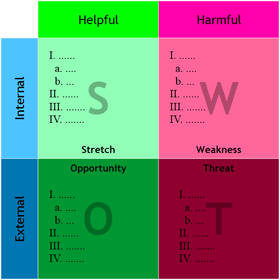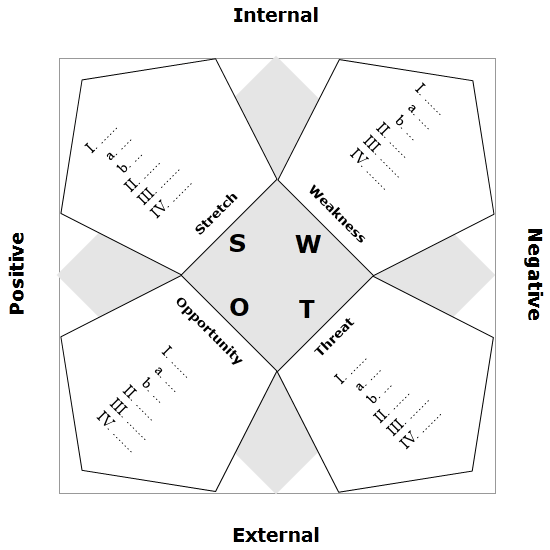Swot analysis

What is SWOT
Any segmentation starts from comprehensive research of a market situation in which the company works and estimation of opportunities and threats that it can face. SWOT-analysis that is one of the most widespread types of analysis in marketing is used as a benchmark for such a review. In other words, SWOT-analysis allows revealing and structuring Strengths and Weaknesses of a company and also potential Opportunities and Threats. Managers compare internal strengths and weaknesses of the company to opportunities given by the market. Considering quality of conformity the decision in what direction the organization should develop its activity is made and finally distribution of resources for segments is determined
Why use SWOT analysis
SWOT is used to develop strategies and plans to achieve some objective and it helps to see the whole situation and possible scenarios of further activity.
SWOT analysis can be used not only by commercial organizations. It is used when someone needs to make some decision that is thought over and has strong basis. It can be both big non-profit organizations and individuals.
How Grapholite can help
Grapholite allows you to easier create a SWOT by offering the following abilities:
- smart drawing tools, automatic connectors and shape library to create flow charts of processes, algorithms and procedures;
- export to the most commonly used picture and document formats.
SWOT analysis rules
Thanks to the conceptual simplicity SWOT can be easily used by managers and in this way can be a subject to wrong use. To carry out SWOT analysis you are not required to have neither extensive databases nor formal preparation. Anyone who has some knowledge about the company and also knows the market can create a simple SWOT. On the other hand, simplicity essential in the analysis can lead to the hasty and senseless decisions. In addition, sometimes users forget about objectivity and rely on the out-of-date or unreliable information.
To avoid the specified errors and to take maximum from the SWOT-analysis, follow these simple rules.
Rule 1. Carefully specify sphere of each SWOT-analysis. The companies often carry out the general analysis covering the whole business. Most likely, it will be too general and useless for managers who are interested in possibilities in the definite markets or segments. SWOT-analysis focusing, for example on a definite segment, makes it possible to discover the most important strengths and weaknesses, opportunities and threats.
Rule 2. You should understand distinctions between the SWOT elements: strengths, weaknesses, opportunities and threats. Strengths and weaknesses are internal characteristics of the company, hence, under its control. Opportunities and threats are connected with characteristics of the market environment and are not subject to organization influence.
Rule 3. Strengths and weaknesses can be considered as those only if they are perceived in this way by buyers. It is necessary to include in the analysis only the most relevant advantages and weaknesses. Remember that they should be determined in relation to the offers of competitors. Strength will be strong only when it is seen as such by the market. For example, quality of a product will be strength only if it works better than competing products. And at last, there can be a lot of such strengths and weaknesses, so you will not understand which of them are the main things. In order to avoid this, strengths and weakness should be ranged according to their importance in the opinion of buyers.
Rule 4. Be impersonal and use the versatile incoming information. Certainly, it is not always possible to carry out the analysis by results of extensive marketing researches. But, on the other hand, it is impossible to charge it to a single person as it won’t be so exact and deep, as the analysis which has been conducted in the form of group discussion and an exchange of ideas. It is important to understand that the SWOT-analysis is not simple numeration of managers’ suspicions. It should be based on the objective facts and the research data.
Rule 5. Avoid vast and ambiguous statements. Often the SWOT-analysis is weakened because similar statements which, most likely, mean nothing for the majority of buyers are included in it. The more precise the statement is, the more useful the analysis will be.

Elements of the internal environment: strengths and weaknesses
Strengths and weaknesses cover variety of aspects of the company activity. Below are the categories that are often included in the analysis. Every SWOT is unique and can include one or two of them, and even all at once. Each element depending on buyers' perception can be both strength and weakness.
- Marketing
- Product
- Pricing
- Promotion
- Marketing information/investigation
- Service/personnel
- Distributions/distributors
- Trademarks and positioning
- Engineering and development of new products. The communication of marketing and technical department becomes closer and the given elements will be more important. For example, the strong interaction between the development team and the marketing department allows the use of buyers’ feedback in design of a new product.
- Operational activity
- Manufacturing/engineering
- Sale and marketing
- Processing of orders/transactions
- Personnel
- Researches and developments
- Distributors
- Marketing
- Sale
- Post-sale service/maintenance
- Customer service/maintenance
- Management
- Company Resources. Resources define availability of personnel and finance and in this way affect ability of the company to benefit from definite opportunities.
Elements of the external environment: opportunities and threats
Opportunities and threats are out of the organization control. Thus, they can be considered as external, concerning elements of the market environment. Basic elements to be considered include:
- Legislation/regulatory/political forces;
- Public forces (culture). Directly influence the company when dissatisfied buyers press upon the organizations which activity is considered as unacceptable;
- Technological forces. The technological abilities helping the company to reach the purposes influence products that are offered to the buyers and on their feedback;
- Economic situationThe general state of the economy influences consumer demand and manner to spend money;
- Competition. The nature and scale of competitive threat. The special attention is paid to the following moments:
- Intensity of a competition
- Threat of occurrence of new competitors
- Buyers’ demands
- The market power of buyers, distributors, suppliers
- Competitiveness
- Pressure from the goods-substitutes